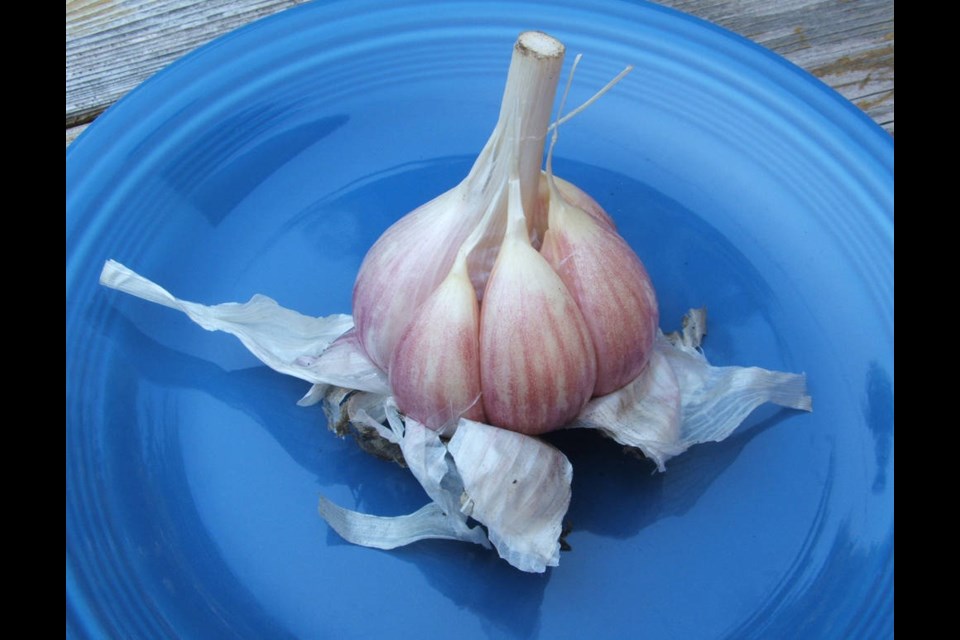Dear Helen: I managed to grow decent garlic bulbs last year and again this year, and would like to use some of the bulbs for planting in the fall. My question: Should I plant bulbs still left from last summer’s harvest or should I use this summer’s bulbs?
A.S.
Use the best of the new bulbs, ones you dug and cured this summer. They will produce stronger plants and better bulbs next summer than would the depleted year-old bulbs.
Plant in a sunny spot with a fertile, humus-rich soil that drains efficiently of excess moisture in winter rains. In recent years I’ve found that my finest, largest bulbs have resulted from a planting made in the third week of September.
Dear Helen: I need help identifying a plant a friend gave me. In a large pot it has produced numerous stems bearing oval leaves with serrated edges and spikes of small purple flowers. The leaves have a distinct anise scent.
A.L.
Your plant is most likely anise-hyssop (Agastache), a strongly anise-scented hardy perennial with showy spikes of purple flowers that attract and feed bees, butterflies, and hummingbirds. It’s a good pollinator plant.
Anise-hyssop is also a low-maintenance plant. In the open garden it is tolerant of drought once the plant is well established, and it is said to be resistant to deer browsing.
Dear Helen: Why did the main branch of a potted cherry tomato turn black and the tomatoes turn dark, hard, and bitter? I’d appreciate some tips on avoiding such problems next year.
E.L.
There are numerous fungal and bacterial diseases that can cause the symptoms you describe.
Because some varieties are more disease-prone than others, it’s always a good idea to grow more than one variety. This allows you to observe which one(s) remain healthy and produce the best tasting tomatoes in your growing conditions.
Provide a large enough container to give the plants room to develop a root structure hefty enough to support good growth and fruiting over the longest period possible. Among my patio tomatoes the smallest plants are in pots 30 cm wide and 25 cm deep. The largest (around 50 cm tall, in tomato cages) are in pots 45 cm wide and 35 cm deep.
A good quality soil mix is a crucial element for success with patio tomatoes. I top the soil up with a nourishing compost in late spring or early summer as flowering and fruiting are about to begin.
Water enough to keep the soil thoroughly and consistently moist but not sodden. Over-watering promotes soft growth that is susceptible to disease. An excess of nitrogen in the soil tends to have the same effect.
Grow the plants in the sun, and try to keep the foliage dry by directing water in a gentle flow onto the soil.
Dear Helen: For 20 years I’ve grown a black-fruited heirloom tomato and another heirloom with flattened, heavily ribbed red fruits side by side, and have saved seed from them from year to year. This year the black-fruited variety produced tomatoes shaped as usual, but without the black colouring. Their colour is exactly like the blocky, red-fruited heirloom. Is a cross between the two varieties possible?
T.C.
Tomato flowers are “perfect,” meaning that each bloom has both male and female parts. To connect the two parts and initiate pollination, all it takes is a breeze or any small movement in the plant.
Though the flowers are self-pollinating, some crossing between varieties can occur from bee activity. For that reason, it is recommended to separate varieties by as much garden space as possible.
Picnic in the Gardens. The Horticulture Centre of the Pacific, 505 Quayle Rd. in Saanich, is hosting Picnic in the Gardens events on Friday, Aug. 20, and Sunday, Aug. 29, with admission by donation starting at 4:30 p.m. and live music from 5 to 8 p.m. Bring a picnic from home or take-out from a local restaurant. No alcohol is permitted. Bring a picnic blanket or folding chair and practise physical distancing. hcp.ca.
VHS meeting. As part of their 100th anniversary celebration, the Victoria Horticultural Society is hosting a special Zoom meeting on Saturday, Aug. 21, from 11 a.m. to 12;30 p.m. James Alexander-Sinclair, a regular columnist in Gardner’s World magazine and current vice-president of the Royal Horticultural Society, will explore “Gardening in a Changing World.” Drop-in fee for non-members is $10. To register, visit vichortsociety.org.



